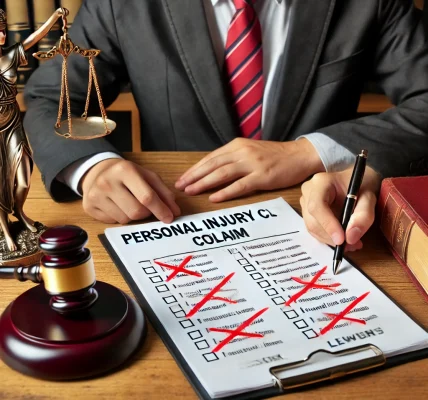Introduction
Negligence is the foundation of most personal injury claims. If you have been injured due to someone else’s actions or failure to act, proving negligence is crucial to obtaining compensation. However, simply being injured does not automatically mean you have a valid claim. To succeed in a personal injury case, you must establish that the other party was legally negligent.
In this guide, we will break down the legal elements of negligence, explain how to prove it, and provide insights on strengthening your claim while avoiding common pitfalls.
What is Negligence?
Negligence is a legal concept that refers to a party’s failure to exercise reasonable care, resulting in harm to another person. In personal injury law, negligence is the basis for holding a person or entity liable for damages. Negligence applies in various cases, including car accidents, slip and falls, medical malpractice, and defective products.
The Four Elements of Negligence
To prove negligence in a personal injury case, the plaintiff (injured party) must establish four key elements:
1. Duty of Care
The first step in proving negligence is demonstrating that the defendant (at-fault party) owed a duty of care to the plaintiff. A duty of care is a legal obligation to act with a certain level of caution to avoid harming others. Examples include:
- Drivers have a duty to follow traffic laws and drive safely.
- Property owners have a duty to maintain a safe environment for visitors.
- Doctors have a duty to provide competent medical care to their patients.
2. Breach of Duty
Once a duty of care is established, the plaintiff must show that the defendant breached this duty. A breach occurs when the defendant fails to act in a reasonable manner. Examples include:
- A driver running a red light and causing an accident.
- A store owner failing to clean up a spill, leading to a slip and fall.
- A doctor making a serious error in a medical procedure.
3. Causation
It is not enough to prove that the defendant was careless; the plaintiff must show that the defendant’s breach of duty directly caused the injury. This is often broken down into two types:
- Actual Cause (Cause-in-Fact): The injury would not have occurred without the defendant’s actions.
- Proximate Cause: The injury was a foreseeable result of the defendant’s actions.
For example, if a driver runs a stop sign and hits a pedestrian, it is clear that their negligence directly caused the injury.
4. Damages
Finally, the plaintiff must prove they suffered actual harm or losses due to the defendant’s negligence. Damages may include:
- Medical bills
- Lost wages
- Pain and suffering
- Emotional distress
- Property damage
Without tangible damages, there is no valid personal injury claim.
Evidence Needed to Prove Negligence
Building a strong personal injury case requires substantial evidence. Below are key types of evidence that can help prove negligence:
1. Accident Reports
Police reports and incident reports can provide crucial details about the accident and help establish liability.
2. Witness Statements
Eyewitness testimonies can strengthen your case by providing independent accounts of what happened.
3. Photographic and Video Evidence
Pictures of the accident scene, injuries, and property damage can serve as compelling proof of negligence.
4. Medical Records
Detailed medical records and doctor’s statements are essential for proving the extent of your injuries and linking them to the accident.
5. Expert Testimony
Medical experts, accident reconstruction specialists, and other professionals can help establish negligence and causation.
Steps to Take After an Accident to Strengthen Your Claim
Taking the right steps immediately after an accident can significantly impact the outcome of your claim:
- Seek Medical Attention – Get medical help immediately, even if injuries seem minor.
- Document Everything – Take photos, gather witness information, and keep all records.
- Report the Incident – File a police report or notify relevant authorities.
- Do Not Admit Fault – Avoid making statements that could be used against you.
- Consult a Personal Injury Lawyer – Legal guidance can help protect your rights and maximize your compensation.
Common Defenses Against Negligence Claims
Defendants in personal injury cases often raise defenses to avoid liability. Some common defenses include:
1. Comparative Negligence
If the plaintiff is partially responsible for the accident, their compensation may be reduced. Some states follow pure comparative negligence, allowing recovery even if the plaintiff is 99% at fault, while others follow modified comparative negligence, barring recovery if the plaintiff is more than 50% at fault.
2. Assumption of Risk
If the plaintiff knowingly engaged in a risky activity (e.g., attending a sports event where injuries are foreseeable), the defendant may argue that they assumed the risk.
3. Lack of Causation
The defense may argue that the plaintiff’s injuries were pre-existing or caused by something unrelated to the defendant’s actions.
4. Statute of Limitations
Every state has a deadline for filing personal injury claims. If the plaintiff misses this deadline, they may lose the right to sue.
Conclusion
Proving negligence in a personal injury case requires clear evidence and a strong legal strategy. Understanding the four elements of negligence—duty of care, breach of duty, causation, and damages—is essential for building a solid case. Collecting relevant evidence, seeking prompt medical treatment, and consulting a lawyer can significantly improve your chances of a successful claim.
If you believe you have a personal injury case, taking the right steps early can make all the difference. While this guide provides general legal insights, it is always advisable to consult with a personal injury attorney to assess the specifics of your case.
Disclaimer: This article is for informational purposes only and does not constitute legal advice. Always consult a qualified attorney for legal guidance related to your specific situation.




